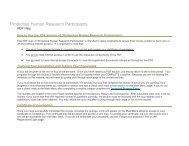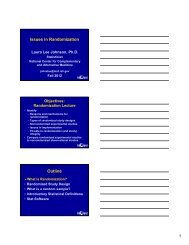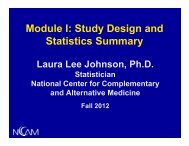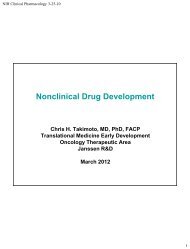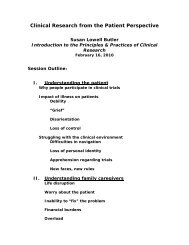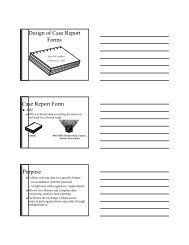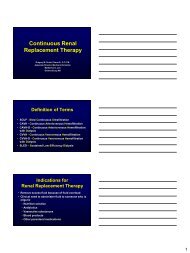Sample Size and Power
Sample Size and Power
Sample Size and Power
- No tags were found...
Create successful ePaper yourself
Turn your PDF publications into a flip-book with our unique Google optimized e-Paper software.
<strong>Sample</strong> <strong>Size</strong> <strong>and</strong> <strong>Power</strong>Laura Lee Johnson, Ph.D.StatisticianNational Center for Complementary<strong>and</strong> Alternative Medicinejohnslau@mail.nih.govFall 2008
Objectives• Calculate changes in sample sizebased on changes in the difference ofinterest, variance, or number of studyarms• Underst<strong>and</strong> intuition behind powercalculations• Recognize sample size formulas for thetests• Learn tips for getting through an IRB
Take Away Message• Get some input from a statistician– This part of the design is vital <strong>and</strong>mistakes can be costly!• Take all calculations with a few grainsof salt– “Fudge factor” is important!• Round UP, never down (ceiling)– Up means 10.01 becomes 11• Analysis Follows Design
Vocabulary• Arm = <strong>Sample</strong> = Group• Demonstrate superiority– Detect difference between treatments• Demonstrate equally effective– Equivalence trial or a 'negative' trial– <strong>Sample</strong> size required to demonstrateequivalence larger than required todemonstrate a difference• Demonstrate non-inferiority– Lots of issues
Superiority vs. EquivalenceSuperioritySuperiority
Non-Inferiority
Vocabulary (2)• Follow-up period– How long a participant is followed• Censored– Participant is no longer followed• Incomplete follow-up (common)• Administratively censored (end ofstudy)• More in our next lecture
Outline‣<strong>Power</strong>• Basic <strong>Sample</strong> <strong>Size</strong> Information• Examples (see text for more)• Changes to the basic formula• Multiple comparisons• Poor proposal sample size statements• Conclusion <strong>and</strong> Resources
<strong>Power</strong> Depends on <strong>Sample</strong> <strong>Size</strong>• <strong>Power</strong> = 1-β = P( reject H 0 | H 1 true )– “Probability of rejecting the nullhypothesis if the alternativehypothesis is true.”• More subjects higher power
<strong>Power</strong> is Affected by…..• Variation in the outcome (σ 2 )– ↓σ 2 → power ↑• Significance level (α)– ↑α →power ↑• Difference (effect) to be detected (δ)– ↑δ →power ↑• One-tailed vs. two-tailed tests– <strong>Power</strong> is greater in one-tailed tests than incomparable two-tailed tests
<strong>Power</strong> Changes• 2n = 32, 2 sample test, 81% power,δ=2, σ = 2, α = 0.05, 2-sided test• Variance/St<strong>and</strong>ard deviation– σ: 2 → 1 <strong>Power</strong>: 81% → 99.99%– σ: 2 → 3 <strong>Power</strong>: 81% → 47%• Significance level (α)– α : 0.05 → 0.01 <strong>Power</strong>: 81% → 69%– α : 0.05 → 0.10 <strong>Power</strong>: 81% → 94%
<strong>Power</strong> Changes• 2n = 32, 2 sample test, 81% power, δ=2,σ = 2, α = 0.05, 2-sided test• Difference to be detected (δ)– δ : 2 → 1 <strong>Power</strong>: 81% → 29%– δ : 2 → 3 <strong>Power</strong>: 81% → 99%• <strong>Sample</strong> size (n)– n: 32 → 64 <strong>Power</strong>: 81% → 98%– n: 32 → 28 <strong>Power</strong>: 81% → 75%• Two-tailed vs. One-tailed tests– <strong>Power</strong>: 81% → 88%
<strong>Power</strong> should be….?• Phase III: industry minimum = 80%• Some say Type I error = Type IIerror• Many large “definitive” studieshave power around 99.9%• Proteomics/genomics studies: aimfor high power because Type IIerror a bear!
<strong>Power</strong> Formula• Depends on study design• Not hard, but can be VERY algebraintensive• May want to use a computerprogram or statistician
Outline<strong>Power</strong>‣Basic <strong>Sample</strong> <strong>Size</strong> Information• Examples (see text for more)• Changes to the basic formula• Multiple comparisons• Rejected sample size statements• Conclusion <strong>and</strong> Resources
Basic <strong>Sample</strong> <strong>Size</strong> Information• What to think about before talkingto a statistician• What information to take to astatistician– In addition to the background to theproject
<strong>Sample</strong> <strong>Size</strong> Formula Information• Variables of interest– type of data e.g. continuous, categorical• Desired power• Desired significance level• Effect/difference of clinical importance• St<strong>and</strong>ard deviations of continuousoutcome variables• One or two-sided tests
<strong>Sample</strong> <strong>Size</strong> & Data Structure• Paired data• Repeated measures• Groups of equal sizes• Hierarchical or nested data
<strong>Sample</strong> <strong>Size</strong> & Study Design• R<strong>and</strong>omized controlled trial (RCT)• Block/stratified-block r<strong>and</strong>omized trial• Equivalence trial• Non-r<strong>and</strong>omized intervention study• Observational study• Prevalence study• Measuring sensitivity <strong>and</strong> specificity
Nonr<strong>and</strong>omized?• Non-r<strong>and</strong>omized studies lookingfor differences or associations– Require larger sample to allowadjustment for confounding factors• Absolute sample size is of interest– Surveys sometimes take % ofpopulation approach
Take Away• Study’s primary outcome– Basis for sample size calculation– Secondary outcome variables consideredimportant? Make sure sample size issufficient• Increase the ‘real’ sample size to reflectloss to follow up, expected responserate, lack of compliance, etc.– Make the link between the calculation <strong>and</strong>increase
Outline<strong>Power</strong>Basic sample size information‣Examples (see text for more)• Changes to the basic formula• Multiple comparisons• Rejected sample size statements• Conclusion <strong>and</strong> Resources
<strong>Sample</strong> <strong>Size</strong> in Clinical Trials• Two groups• Continuous outcome• Mean difference• Similar ideas hold for otheroutcomes
Phase I: Dose Escalation• Dose limiting toxicity (DLT) mustbe defined• Decide a few dose levels (e.g. 4)• At least three patients will betreated on each dose level (cohort)• Not a power or sample sizecalculation issue
Phase I (Old Way)• Enroll 3 patients• If 0 out of 3 patients develop DLT– Escalate to new dose• If DLT is observed in 1 of 3 patients– Exp<strong>and</strong> cohort to 6– Escalate if 0 out of the 3 new patientsdo not develop DLT (i.e. 1/6 at thatdose develop DLT)
Phase IEnroll 3 people0/3 DLT 1/3 DLT 2 or 3 / 3 DLTEscalate tonew doseEnroll 3 moreat same dose0/new 3 DLT 1 or more /new 3 DLTEscalate tonew doseStopStopDropdowndose;startover
Phase IEnroll 3 people0/3 DLT 1/3 DLT 2 or 3 / 3 DLTEscalate tonew doseEnroll 3 moreat same dose0/new 3 DLT 1 or more /new 3 DLTEscalate tonew doseStopStopDropdowndose;startover
Phase IEnroll 3 people0/3 DLT 1/3 DLT 2 or 3 / 3 DLTEscalate tonew doseEnroll 3 moreat same dose0/new 3 DLT 1 or more /new 3 DLTEscalate tonew doseStopStopDropdowndose;startover
Phase IEnroll 3 people0/3 DLT 1/3 DLT 2 or 3 / 3 DLTEscalate tonew doseEnroll 3 moreat same dose0/new 3 DLT 1 or more /new 3 DLTEscalate tonew doseStopStopDropdowndose;startover
Phase IEnroll 3 people0/3 DLT 1/3 DLT 2 or 3 / 3 DLTEscalate tonew doseEnroll 3 moreat same dose0/new 3 DLT 1 or more /new 3 DLTEscalate tonew doseStopStopDropdowndose;startover
Phase IEnroll 3 people0/3 DLT 1/3 DLT 2 or 3 / 3 DLTEscalate tonew doseEnroll 3 moreat same dose0/new 3 DLT 1 or more /new 3 DLTEscalate tonew doseStopStopDropdowndose;startover
Phase IEnroll 3 people0/3 DLT 1/3 DLT 2 or 3 / 3 DLTEscalate tonew doseEnroll 3 moreat same dose0/new 3 DLT 1 or more /new 3 DLTEscalate tonew doseStopStopDropdowndose;startover
Phase I (cont.)• Maximum Tolerated Dose (MTD)– Dose level immediately below thelevel at which ≥2 patients in a cohortof 3 to 6 patients experienced a DLT• Usually go for “safe dose”– MTD or a maximum dosage that ispre-specified in the protocol
Number of pts with DLT0/31/30/3 + 0/3(To get here a de-escalation rulemust have been applied at thenext higher dose level)1/3 + 0/31/3 + {1/3* or 2/3 or 3/3}2/3 or 3/3DecisionEscalate one levelEnroll 3 more at current levelSTOP <strong>and</strong> choose current level as MTDEscalate one level(unless a de-escalation rule was applied atnext higher level, in which case choosecurrent level as MTD)STOP* <strong>and</strong> choose previous level asMTD(unless previous level has only 3 patients, inwhich case treat 3 more at previous level)STOP <strong>and</strong> choose previous level as MTD(unless previous level has only 3 patients, inwhich case treat 3 more at previous level)
Phase I Note• *Implicitly targets a dose with Pr(Toxicity) ≤ 0.17; if at 1/3+1/3 decidecurrent level is MTD then the Pr(Toxicity) ≤ 0.33• Entry of patients to a new dose leveldoes not occur until all patients in theprevious level are beyond a certaintime frame where you look for toxicity• Not a power or sample size calculationissue
Phase I• MANY new methods• Several r<strong>and</strong>omize to multiple arms• Several have control arms• Several have 6-15 people per arm
Phase II Designs• Screening of new therapies• Not to prove ‘final’ efficacy, usually– Efficacy based on surrogate outcome• Sufficient activity to be tested in ar<strong>and</strong>omized study• Issues of safety still important• Small number of patients
Phase II Design Problems• Placebo effect• Investigator bias• Might be unblinded or singleblinded treatment• Regression to the mean
Phase II Example:Two-Stage Optimal Design• Single arm, two stage, using anoptimal design & predefinedresponse• Rule out response probability of20% (H 0 : p=0.20)• Level that demonstrates usefulactivity is 40% (H 1 :p=0.40)• α = 0.10, β = 0.10
Phase II:Two-Stage Optimal Design• Seek to rule out undesirably lowresponse probability– E.g. only 20% respond (p0=0.20)• Seek to rule out p0 in favor of p1;shows “useful” activity– E.g. 40% are stable (p1=0.40)
Two-Stage Optimal Design• Let α = 0.1 (10% probability ofaccepting a poor agent)• Let β = 0.1 (10% probability ofrejecting a good agent)• Charts in Simon (1989) paper withdifferent p1 – p0 amounts <strong>and</strong>varying α <strong>and</strong> β values
Table from Simon (1989)
Blow up: Simon (1989) Table
Phase II Example• Initially enroll 17 patients.– 0-3 of the 17 have a clinical responsethen stop accrual <strong>and</strong> assume not anactive agent• If ≥ 4/17 respond, then accrual willcontinue to 37 patients
Phase II Example• If 4-10 of the 37 respond this isinsufficient activity to continue• If ≥ 11/37 respond then the agent will beconsidered active• Under this design if the null hypothesiswere true (20% response probability)there is a 55% probability of earlytermination
<strong>Sample</strong> <strong>Size</strong> Differences• If the null hypothesis (H 0 ) is true• Using two-stage optimal design– On average 26 subjects enrolled• Using a 1-sample test of proportions– 34 patients– If feasible• Using a 2-sample r<strong>and</strong>omized test ofproportions– 86 patients per group
Phase II• Newer methods are available• Many cite Simon (thus, why wewent through it)
Phase II: Historical Controls• Want to double disease X survivalfrom 15.7 months to 31 months.• α = 0.05, one tailed, β = 0.20• Need 60 patients, about 30 in eachof 2 arms; can accrue 1/month• Need 36 months of follow-up• Use historical controls
Phase II: Historical Controls• Old data set from 35 patients treated atNCI with disease X, initially treatedfrom 1980 to 1999• Currently 3 of 35 patients alive• Median survival time for historicalpatients is 15.7 months• Almost like an observational study• Use Dixon <strong>and</strong> Simon (1988) method foranalysis
Phase II SummaryStudyDesign1 arm1 arm2-stageHistoricalcontrols2(+) armAdvantagesSmall nSmall n, stopearlySmall n,some controlControlDisadvantagesNo controlNo control,correct rulesAccuratecontrol ?Larger n
Phase III Survival Example• Primary objective: determine ifpatients with metastatic melanomawho undergo Procedure A have adifferent overall survival comparedwith patients receiving st<strong>and</strong>ard ofcare (SOC)• Trial is a two arm r<strong>and</strong>omizedphase III single institution trial
Number of Patients to Enroll?• 1:1 ratio between the two arms• 80% power to detect a differencebetween 8 month median survival <strong>and</strong>16 month median survival• Two-tailed α = 0.05• 24 months of follow-up after the lastpatient has been enrolled• 36 months of accrual
341213
Phase III Survival• Look at nomograms (Schoenfeld<strong>and</strong> Richter). Can use formulas• Need 38/arm, so let’s try to recruit42/arm – total of 84 patients• Anticipate approximately 30patients/year entering the trial
Non-Survival Simple <strong>Sample</strong> <strong>Size</strong>• Start with 1-arm or 1-sample study• Move to 2-arm study• Study with 3+ arms cheat trick– Calculate PER ARM sample size for2-arm study– Use that PER ARM– Does not always work; typically ok
1-<strong>Sample</strong> N Example• Study effect of new sleep aid• 1 sample test• Baseline to sleep time after taking themedication for one week• Two-sided test, α = 0.05, power = 90%• Difference = 1 (4 hours of sleep to 5)• St<strong>and</strong>ard deviation = 2 hr
Sleep Aid Example• 1 sample test• 2-sided test, α = 0.05, 1-β = 90%• σ = 2hr (st<strong>and</strong>ard deviation)• δ = 1 hr (difference of interest)2 2 2 2( Z1 −α/2 + Z1−β) σ (1.960 + 1.282) 2n = = = 42.04 ≈432 2δ1
Short Helpful Hints• In humans n = 12-15 givessomewhat stable variance– Not about power, about stability– 15/arm minimum good rule of thumb• If n < 20-30, check t-distribution• Minimum 10 participants/variable– Maybe 100 per variable
<strong>Sample</strong> <strong>Size</strong>:Change Effect or Difference• Change difference of interest from 1hrto 2 hr• n goes from 43 to 112 2(1.960 + 1.282) 2n = = 10.51 ≈1122
<strong>Sample</strong> <strong>Size</strong>:Iteration <strong>and</strong> the Use of t• Found n = 11 using Z• Use t 10 instead of Z– t n-1 for a simple 1 sample• Recalculate, find n = 13• Use t 12• Recalculate sample size, find n = 13– Done• Sometimes iterate several times
<strong>Sample</strong> <strong>Size</strong>: Change <strong>Power</strong>• Change power from 90% to 80%• n goes from 11 to 8• (Small sample: start thinking aboutusing the t distribution)2 2(1.960 + 0.841) 2n = = 7.85 ≈822
<strong>Sample</strong> <strong>Size</strong>:Change St<strong>and</strong>ard Deviation• Change the st<strong>and</strong>ard deviation from 2to 3• n goes from 8 to 182 2(1.960 + 0.841) 3n = = 17.65 ≈1822
Sleep Aid Example: 2 ArmsInvestigational, Control• Original design (2-sided test, α = 0.05, 1-β =90%, σ = 2hr, δ = 1 hr)• Two sample r<strong>and</strong>omized parallel design• Needed 43 in the one-sample design• In 2-sample need twice that, in each group!• 4 times as many people are needed in thisdesign2 2 2 22( Z1 −α/2 + Z1−β) σ 2(1.960 + 1.282) 2n = = = 84.1 ≈85 →170total!2 2δ1
Sleep Aid Example: 2 ArmsInvestigational, Control• Original design (2-sided test, α = 0.05, 1-β =90%, σ = 2hr, δ = 1 hr)• Two sample r<strong>and</strong>omized parallel design• Needed 43 in the one-sample design• In 2-sample need twice that, in each group!• 4 times as many people are needed in thisdesign2 2 2 22( Z1 −α/2 + Z1−β) σ 2(1.960 + 1.282) 2n = = = 84.1 ≈85 →170total!2 2δ1
Aside: 5 Arm Study• <strong>Sample</strong> size per arm = 85• 85*5 = 425 total– Similar 5 arm study– Without considering multiplecomparisons
<strong>Sample</strong> <strong>Size</strong>:Change Effect or Difference• Change difference of interest from 1hrto 2 hr• n goes from 170 to 442 22(1.960 + 1.282) 2n = = 21.02 ≈22 →44total22
<strong>Sample</strong> <strong>Size</strong>: Change <strong>Power</strong>• Change power from 90% to 80%• n goes from 44 to 322 22(1.960 + 0.841) 2n = = 15.69 ≈16 →32total22
<strong>Sample</strong> <strong>Size</strong>:Change St<strong>and</strong>ard Deviation• Change the st<strong>and</strong>ard deviation from 2to 3• n goes from 32 to 722 22(1.960 + 0.841) 3n = = 35.31 ≈36 →72total22
Conclusion• Changes in the difference of interest have HUGEimpacts on sample size– 20 point difference → 25 patients/group– 10 point difference → 100 patients/group– 5 point difference → 400 patients/group• Changes in difference to be detected, α, β, σ,number of samples, if it is a 1- or 2-sided test can allhave a large impact on your sample size calculation2-Arm Study’sTOTAL <strong>Sample</strong> <strong>Size</strong> =2N=+ Z2σ21 −α/2 1−β 4( Z )δ2
Live Statistical Consult!• <strong>Sample</strong> size/<strong>Power</strong> calculation:cholesterol in hypertensive menexample (Hypothesis Testing lecture)• Choose your study design– Data on 25 hypertensive men (mean 220,s=38.6)– 20-74 year old male population: meanserum cholesterol is 211 mg/ml with ast<strong>and</strong>ard deviation of 46 mg/ml
Example• Calculate power with the numbersgiven• What is the power to see a 19 pointdifference in mean cholesterol with25 people in– Was it a single sample or 2 sampleexample?
<strong>Sample</strong> <strong>Size</strong> Rulers
JAVA <strong>Sample</strong> <strong>Size</strong>
Put in 1-<strong>Sample</strong> Example #s• 1 arm, t-test• Sigma (sd) = 38.6• True difference of means = 220-211=9• n=25• 2 sided (tailed) alpha = 0.05– <strong>Power</strong>=XXXX• 90% power– Solve for sample size n=XXXX
Move the Values Around• Sigma (st<strong>and</strong>ard deviation, sd)• Difference between the means
Put in 2-<strong>Sample</strong> Example #s• 2 arms, t-test• Equal sigma (sd) in each arm = 2• 2 sided (tailed) alpha = 0.05• True difference of means = 1• 90% power• Solve for sample size
Keep Clicking “OK” Buttons
Other Designs?
<strong>Sample</strong> <strong>Size</strong>:Matched Pair Designs• Similar to 1-sample formula• Means (paired t-test)– Mean difference from paired data– Variance of differences• Proportions– Based on discordant pairs
Examples in the Text• Several with paired designs• Two <strong>and</strong> one sample means• Proportions• How to take pilot data <strong>and</strong> designthe next study
Cohen's Effect <strong>Size</strong>s• Large (.8), medium (.5), small (.2)• Popular esp. in social sciences• Do NOT use– Need to think• ‘Medium’ yields same sample sizeregardless of what you aremeasuring
Take Home: What you need for N• What difference is scientificallyimportant in units – thought, disc.– 0.01 inches?– 10 mm Hg in systolic BP?• How variable are themeasurements (accuracy)? – Pilot!– Plastic ruler, Micrometer, Caliper
Take Home: N• Difference (effect) to be detected (δ)• Variation in the outcome (σ 2 )• Significance level (α)– One-tailed vs. two-tailed tests• <strong>Power</strong>• Equal/unequal arms• Superiority or equivalence
Outline<strong>Power</strong>Basic sample size informationExamples (see text for more)‣Changes to the basic formula/Observational studies• Multiple comparisons• Rejected sample size statements• Conclusion <strong>and</strong> Resources
Unequal #s in Each Group• Ratio of cases to controls• Use if want λ patients r<strong>and</strong>omized to thetreatment arm for every patient r<strong>and</strong>omizedto the placebo arm• Take no more than 4-5 controls/casenn= λn→λcontrols for every case2 1( Z + Z ) ( σ + σ / λ)2 2 21 −α/2 1−β1 21=2δ
K:1 <strong>Sample</strong> <strong>Size</strong> Shortcut• Use equal variance sample sizeformula: TOTAL sample sizeincreases by a factor of(k+1) 2 /4k• Ex: Total sample size for two equalgroups = 26; want 2:1 ratio• 26*(2+1) 2 /(4*2) = 26*9/8 = 29.25 ≈ 30• 20 in one group <strong>and</strong> 10 in the other
Unequal #s in Each Group:Fixed # of Cases• Case-Control Study• Only so many new devices• <strong>Sample</strong> size calculation says n=13cases <strong>and</strong> controls are needed• Only have 11 cases!• Want the same precision• n 0 = 11 cases• kn 0 = # of controls
How many controls?k=2nn0−n• k = 13 / (2*11 – 13) = 13 / 9 = 1.44• kn 0 = 1.44*11 ≈ 16 controls (<strong>and</strong> 11cases) = 27 total (controls + cases)– Same precision as 13 controls <strong>and</strong> 13cases (26 total)
# of Events is Important• Cohort of exposed <strong>and</strong> unexposedpeople• Relative Risk = R• Prevalence in the unexposedpopulation = π 1
Formulas <strong>and</strong> ExampleRnnn=Risk of event in exposed groupRisk of event in unxposed group2( Z + Z )= = #of eventsin unexposed group2( R −1)= Rn = #events in exposed group1 −α/2 1−β1 22 1<strong>and</strong> n are the number of events in the two groups1 2required to detect a relative risk of R with power 1-βN = n / π = # subjects per group1 1
# of Covariates <strong>and</strong> # of Subjects• At least 10 subjects for every variableinvestigated– In logistic regression– No general theoretical justification– This is stability, not power– Peduzzi et al., (1985) unpredictable biasedregression coefficients <strong>and</strong> varianceestimates• Principal component analysis (PCA)(Thorndike 1978 p 184): N≥10m+50 or even N≥ m 2 + 50
Balanced Designs: Easier to Find<strong>Power</strong> / <strong>Sample</strong> <strong>Size</strong>• Equal numbers in two groups isthe easiest to h<strong>and</strong>le• If you have more than two groups,still, equal sample sizes easiest• Complicated design = simulations– Done by the statistician
Outline<strong>Power</strong>Basic <strong>Sample</strong> <strong>Size</strong> InformationExamples (see text for more)Changes to the basic formula‣Multiple comparisons• Rejected sample size statements• Conclusion <strong>and</strong> Resources
Multiple Comparisons• If you have 4 groups– All 2 way comparisons of means– 6 different tests• Bonferroni: divide α by # of tests– 0.025/6 ≈ 0.0042– Common method; long literature• High-throughput laboratory tests
DNA Microarrays/Proteomics• Same formula (Simon et al. 2003)– α = 0.001 <strong>and</strong> β = 0.05– Possibly stricter• Simulations (Pepe 2003)– based on pilot data– k 0 = # genes going on for further study– k 1 = rank of genes want to ensure you getP[ Rank (g) ≤ k 0 | True Rank (g) ≤ k 1 ]
Outline<strong>Power</strong>Basic <strong>Sample</strong> <strong>Size</strong> InformationExamples (see text for more)Changes to the basic formulaMultiple comparisons‣Rejected sample size statements• Conclusion <strong>and</strong> Resources
Me, too! No, Please Justify N• "A previous study in this area recruited150 subjects <strong>and</strong> found highlysignificant results (p=0.014), <strong>and</strong>therefore a similar sample size shouldbe sufficient here."– Previous studies may have been'lucky' to find significant results, dueto r<strong>and</strong>om sampling variation.
No Prior Information• "<strong>Sample</strong> sizes are not providedbecause there is no prior informationon which to base them."– Find previously publishedinformation– Conduct small pre-study– If a very preliminary pilot study,sample size calculations not usuallynecessary
Variance?• No prior information on st<strong>and</strong>arddeviations– Give the size of difference that maybe detected in terms of number ofst<strong>and</strong>ard deviations
Number of Available Patients• "The clinic sees around 50 patients ayear, of whom 10% may refuse to takepart in the study. Therefore over the 2years of the study, the sample size willbe 90 patients. "– Although most studies need to balancefeasibility with study power, the samplesize should not be decided on the numberof available patients alone.– If you know # of patients is an issue, canphrase in terms of power
Outline<strong>Power</strong>Basic <strong>Sample</strong> <strong>Size</strong> InformationExamples (see text for more)Changes to the basic formulaMultiple comparisonsRejected sample size statements‣Conclusion <strong>and</strong> Resources
Conclusions:What Impacts <strong>Sample</strong> <strong>Size</strong>?• Difference of interest– 20 point difference → 25 patients/group– 5 point difference → 400 patients/group• σ, α, β• Number of arms or samples• 1- or 2-sided testTotal <strong>Sample</strong> <strong>Size</strong> 2-Armed/Group/<strong>Sample</strong> Test2N=4( Z + Z )2σ21 −α/2 1−β δ2
No Estimate of the Variance?• Make a sample size or power table• Make a graph• Use a wide variety of possiblest<strong>and</strong>ard deviations• Protect with high sample size ifpossible
Top 10 Statistics Questions10.Exact mechanism to r<strong>and</strong>omizepatients9. Why stratify? (EMEA re: dynamicallocation8. Blinded/masked personnel‣ Endpoint assessment
Top 10 Statistics Questions7. Each hypothesis‣ Specific analyses‣ Specific sample size6. How / if adjusting for multiplecomparisons5. Effect modification
Top 10 Statistics Questions4. Interim analyses (if yes)‣ What, when, error spending model /stopping rules‣ Accounted for in the sample size ?3. Expected drop out (%)2. How to h<strong>and</strong>le drop outs <strong>and</strong>missing data in the analyses?
Top 10 Statistics Questions1. Repeated measures / longitudinaldata‣ Use a linear mixed model instead ofrepeated measures ANOVA‣ Many reasons to NOT use repeatedmeasures ANOVA; few reasons to use‣ Similarly generalized estimatingequations (GEE) if appropriate
Analysis Follows DesignQuestions → Hypotheses →Experimental Design → <strong>Sample</strong>s →Data → Analyses →Conclusions• Take all of your design information to astatistician early <strong>and</strong> often– Guidance– Assumptions
Resources: General Books• Hulley et al (2001) Designing ClinicalResearch, 2 nd ed. LWW• Rosenthal (2006) Struck by Lightning:The curious world of probabilities• Bl<strong>and</strong> (2000) An Introduction to MedicalStatistics, 3rd. ed. Oxford UniversityPress• Armitage, Berry <strong>and</strong> Matthews (2002)Statistical Methods in MedicalResearch, 4th ed. Blackwell, Oxford
Resources: General/Text Books• Altman (1991) Practical Statistics forMedical Research. Chapman <strong>and</strong> Hall• Fisher <strong>and</strong> Van Belle (1996, 2004) Wiley• Simon et al. (2003) Design <strong>and</strong> Analysisof DNA Microarray Investigations.Springer Verlag• Rosner Fundamentals of Biostatistics.Choose an edition. Has a study guide,too.
<strong>Sample</strong> <strong>Size</strong> Specific Tables• Continuous data: Machin et al. (1998)Statistical Tables for the Design of ClinicalStudies, Second Edition Blackwell, Oxford• Categorical data: Lemeshow et al. (1996)Adequacy of sample size in health studies.Wiley• Sequential trials: Whitehead, J. (1997) TheDesign <strong>and</strong> Analysis of Sequential ClinicalTrials, revised 2nd. ed. Wiley• Equivalence trials: Pocock SJ. (1983) ClinicalTrials: A Practical Approach. Wiley
Resources: Articles• Simon R. Optimal two-stagedesigns for phase II clinical trials.Controlled Clinical Trials. 10:1-10,1989.• Thall, Simon, Ellenberg. A twostagedesign for choosing amongseveral experimental treatments<strong>and</strong> a control in clinical trials.Biometrics. 45(2):537-547, 1989.
Resources: Articles• Schoenfeld, Richter. Nomograms forcalculating the number of patients neededfor a clinical trial with survival as anendpoint. Biometrics. 38(1):163-170, 1982.• Bl<strong>and</strong> JM <strong>and</strong> Altman DG. One <strong>and</strong> two sidedtests of significance. British Medical Journal309: 248, 1994.• Pepe, Longton, Anderson, Schummer.Selecting differentially expressed genes frommicroarry experiments. Biometrics.59(1):133-142, 2003.
Resources: FDA Guidance• http://www.fda.gov/cdrh/ode/odeot476.html (devices, non-diagnostic)• http://www.fda.gov/cdrh/osb/guidance/1620.html (diagnostics)• And all the ones listed before
Resources: URLs• <strong>Sample</strong> size calculations simplified– http://www.tufts.edu/~gdallal/SIZE.HTM• Stat guide: research grant applicants, St.George’s Hospital Medical School(http://www.sgul.ac.uk/depts/chs/chs_research/stat_guide/guide.cfm)– http://tinyurl.com/2mh42a• Software: nQuery, EpiTable, SeqTrial, PS(http://biostat.mc.v<strong>and</strong>erbilt.edu/twiki/bin/view/Main/<strong>Power</strong><strong>Sample</strong><strong>Size</strong>)– http://tinyurl.com/zoysm• Earlier lectures
Questions?



